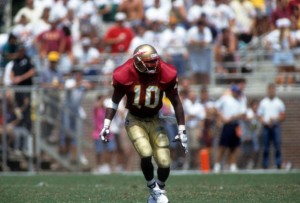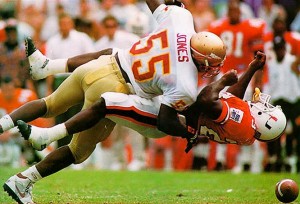Welcome to the first installment of a Noled Out summer series that we’ve been wanting to do for a while! In the Seminole Stand-Off articles, we will look at two Florida State greats who played similar or the same positions and try to determine which one we would rather have on a hypothetical All-Time FSU team.
Some ground rules: A player’s NFL career will not be factored into our analysis — we are strictly looking at college performance/legacy. We will attempt to compare players from similar eras as well, meaning you probably won’t see a Fred Biletnikoff vs. Rashad Greene breakdown. Finally, team accomplishments will certainly have a role but we will try to isolate a single player’s impact in order to make it fair.
The first match-up of the series is a duel of linebackers: Marvin “Shade Tree” Jones, or Derrick “Godfather” Brooks? Jones played from 1990 to 1992 while Brooks played from 1991 to 1994, an almost perfect overlap for us to compare them. It should be noted that Brooks primarily played outside linebacker, but both largely had the same duties in the FSU defense at the time.
Both men currently enjoy spots in the FSU Football Hall of Fame and continue to be sources of lore for those that had the privilege to watch them both play. So which one answers the question set forth at the beginning of the piece? It’s a tough call.
Marvin Jones
Jones came first for the Seminoles, so it’s only right that his case gets pleaded first. Who exactly was the one they called Shade Tree? Well, rival Miami coach Dennis Erickson had this to say back in 1992: “Marvin Jones is the best linebacker I’ve ever seen playing college football. He’s all over the place. When he was a freshman, he was incredible. Now, add two more years and more muscle, and he’s a lot better. He’s truly as good as I’ve ever seen.”
The hype was warranted. Despite only playing three years, Jones amassed 369 tackles, 27 for a loss, 5.5 sacks, and 3 interceptions. After being named a third team AP All-American as a freshman, Marvin would erupt on the national stage and become one of the most ferocious defensive players FSU had ever seen.
While his volume stats may have seen a slight decline in his sophomore and junior years, his effect on the field surely didn’t. As the anchor of a stout Seminole defense, Jones was selected as a Consensus All-American in both 1991 and 1992. His 1992 season is considered one of — if not the — best seasons by a linebacker in football history.
Jones was selected as the Sporting News College Football Player of the Year while winning both the Butkus and Lombardi Awards in the same season. He was simultaneously the best linebacker and best lineman in college football at one point. Oh, he also finished fourth in Heisman voting that year. By the end of the 1992 season, Marvin Jones was the consensus best linebacker in college football.
Jones also brought with him an inspiring story that still stands to amaze those who listen to it. While it won’t factor into our on field examination, it still serves as a great foundation for why Jones became a fan favorite in Tallahassee.
Ultimately, the decision to not stay for a fourth year prevented him from solidifying his place even higher in the FSU record books. That being said he still ranks at No. 8 in all-time tackles at FSU and was the first Seminole player to ever win two national awards in the same season.
While he was there, FSU went 32-5 with three straight bowl victories, including an Orange Bowl win in 1992. The ‘Noles never finished below No. 4 in the AP standings and would start a string of nine straight ACC championships in 1992. Jones helped propel FSU into the well-known dynasty of the 90’s and was also the mentor for a young guy from Pensacola named…Derrick Brooks.
Derrick Brooks

TALLAHASSEE, FL – SEPTEMBER 11: Derrick Brooks #10 of the Florida State Seminoles lines up during an NCAA game against the Clemson Tigers on September 11, 1993 at Doak Campbell Stadium in Tallahassee, Flroida. The Seminoles defeated the Tigers 57-0. (Photo by Scott Halleran/Getty Images)
Much like his predecessor before him, stats really don’t tell the whole story with Derrick Brooks. Many are still surprised to figure out that one of the greatest linebackers of all-time didn’t even start out at the position as he was switched from safety during his freshman year. Brooks even admitted back then that he didn’t think he could succeed at outside linebacker. Hey, if there is one thing to be happy you were wrong about, that would be it.
Brooks played four years at FSU and finished his career with 274 tackles, 8.5 sacks, 4 forced fumbles, 5 interceptions (two returned for a touchdown), and 2 blocked kicks. After a decent year at safety, Bobby Bowden and then-defensive coordinator Mickey Andrews decided that Brooks and his skill set could be special at the outside linebacker position. With the ability to run like a defensive back while hitting like a linebacker, Brooks proved to be a one-man swarm around the field. There wasn’t a single area where he could not make an impact.
After his 1992 selection as a sophomore All-American while playing alongside Marvin Jones, Brooks took over as the leader of the defense. His ability to pressure the quarterback meant offenses would have to account for him on every pass play, and his knack for stopping a runner in his tracks caused many teams to just outright avoid whatever part of the field he was on.
It didn’t work. Brooks was named a consensus All-American in 1993 and 1994 and won the ACC Defensive Player of the Year in 1993. He finished as a finalist for the Vince Lombardi Award in both years and even added All-American academic honors for his senior year.
During his tenure with the team, Florida State went 44-5-1 with four straight bowl victories, three ACC championships, and the team’s first national championship in 1993. His final play as a Seminole was the 1995 Sugar Bowl against the Florida Gators where he picked off Danny Wuerffel to seal the victory for Florida State. How fitting.
Who’s The Choice?
It’s hard to separate what both guys did on the college level from what they did in the NFL. Jones actually had a pretty good career where he racked up over 1,000 tackles…but Brooks turned into a Hall of Fame inductee. Because of this, many people would pick Brooks without question solely for the impact he had on both stages. This is what we are trying to avoid with the comparisons.
Statistically, Jones has a clear edge in stops with more tackles and tackles for loss in three years than Brooks’ four, but it needs to be recognized that he played a position where the tackles come easier. While some will point to Brooks’ all-around efforts and stats, the same argument applies to his position on the field.
The outside linebacker naturally gets more sacks and interceptions than their counterparts on the inside. They are both fairly even with respects to adjusting for position and role in the defense.
Both were consensus All-Americans twice and both had some good personal hardware to put in the trophy case. Yet, this same trophy case is the reason that Derrick Brooks edges Marvin Jones ever-so-slightly.
It might not be fair to let team accomplishments decide the selection, but this is one of the rare cases where the two players are almost completely equal in every other aspect. The only edge either one really has would be that Brooks was more versatile and influenced pass defense more than Jones — yet the reply would be that Jones had a bigger impact in stopping the run than Brooks ever did.
To some extent, that’s the truth. But at the end of the day, Brooks was the leader of a defense that brought FSU its first national title and even more ACC championships.
That being said, Jones still has the distinctions that make this discussion much closer than many people would think. If he had stayed one more year, the argument would have almost certainly have tipped in his favor. As it stands now however, Derrick Brooks gets the nod for his overall versatility and results under his leadership.
Do you agree with the pick? Let us know on Twitter or Facebook or the comments below. If there’s any match-up you want to see dissected, make sure to mention it as well!





















